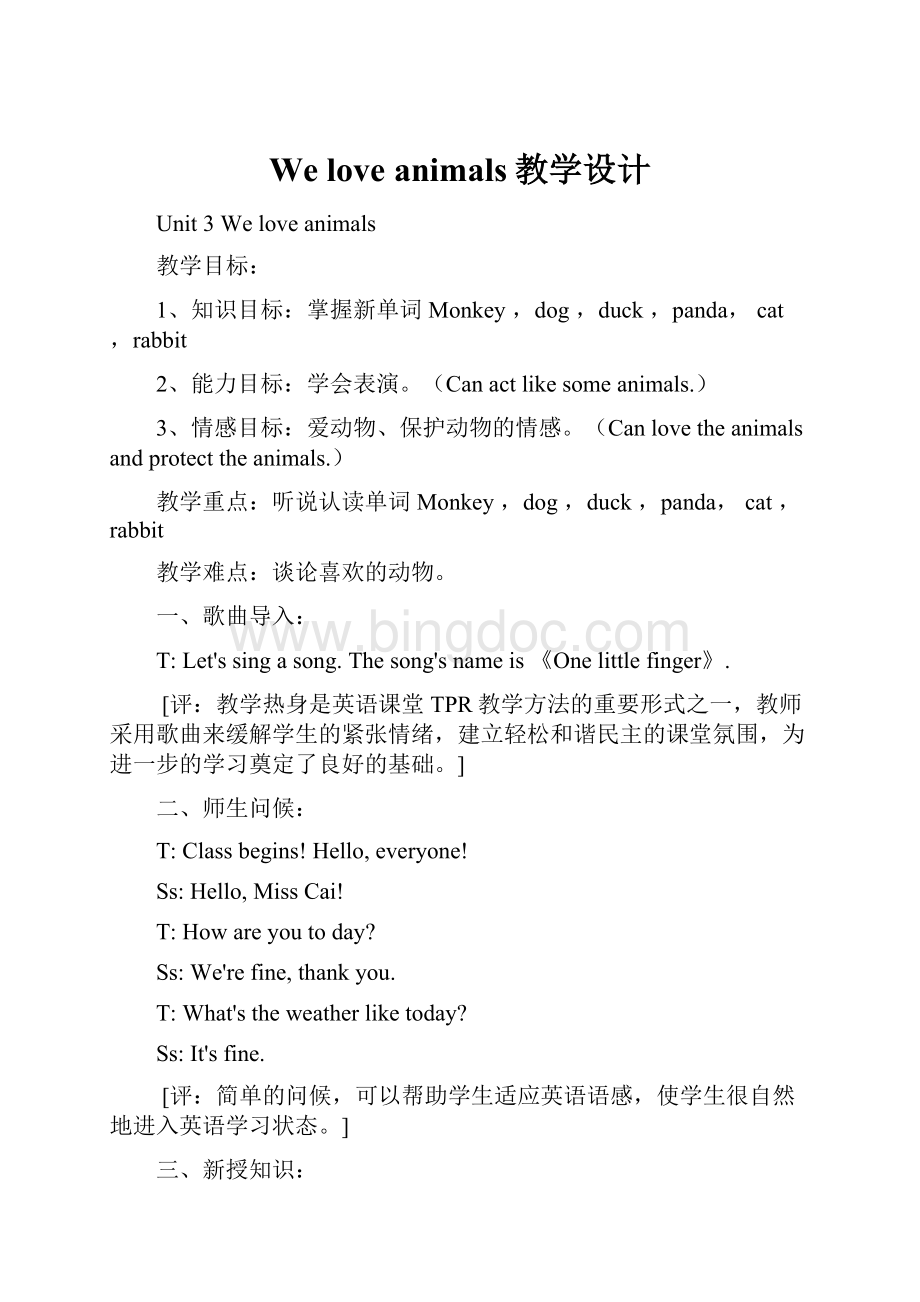We love animals教学设计.docx
《We love animals教学设计.docx》由会员分享,可在线阅读,更多相关《We love animals教学设计.docx(68页珍藏版)》请在冰点文库上搜索。

Weloveanimals教学设计
Unit3Weloveanimals
教学目标:
1、知识目标:
掌握新单词Monkey,dog,duck,panda,cat,rabbit
2、能力目标:
学会表演。
(Canactlikesomeanimals.)
3、情感目标:
爱动物、保护动物的情感。
(Canlovetheanimalsandprotecttheanimals.)
教学重点:
听说认读单词Monkey,dog,duck,panda,cat,rabbit
教学难点:
谈论喜欢的动物。
一、歌曲导入:
T:
Let'ssingasong.Thesong'snameis《Onelittlefinger》.
[评:
教学热身是英语课堂TPR教学方法的重要形式之一,教师采用歌曲来缓解学生的紧张情绪,建立轻松和谐民主的课堂氛围,为进一步的学习奠定了良好的基础。
]
二、师生问候:
T:
Classbegins!
Hello,everyone!
Ss:
Hello,MissCai!
T:
Howareyoutoday?
Ss:
We'refine,thankyou.
T:
What'stheweatherliketoday?
Ss:
It'sfine.
[评:
简单的问候,可以帮助学生适应英语语感,使学生很自然地进入英语学习状态。
]
三、新授知识:
T:
Alovelytoday,isn'tit?
Ihaveagoodnewsforyou.We'regoingtovisitthezoo.Areyouhappy?
Ss:
Yes!
T:
Todaywe'lllearnalessonaboutthezoo.Pleasetellme.Whichlessonshallwelearn?
Ss:
Lesson9
T:
OK!
Now,let'scountfromonetonine!
(教师同时书写板书Lesson9。
)
[评:
在学生原有知识的基础上,以数字引入,使课题的出示别具特色,自然而不失趣味性。
]
T:
Well,whocantellmewhatyoucanfindinthezoo?
Ss:
Monkeys,tigers,andhippos….
T:
Oh,we'llseesomanyanimals.That'sgreat!
Now,pleaselookhere.We'llmeetmanyanimalfriendstoday.What'sthis?
(出示动物头饰)
T:
Doyouhaveamonkey?
S:
No,Idon't.
T:
Oh,Don'tworry.Thismonkeyisforyou!
(S1带上头饰)
(以下lion,hippo,tiger,panda,elephant,dog,goat同上)
T:
Now,wehavesomanyanimals,theyareourbestfriends!
Butlookthere,thereisanotherfriend.She'swaitingtomeetus.Who'sshe?
(指向长颈鹿玩偶)
Ss:
Changjinglu.
T:
Yes,it'saChangjinglu,butinEnglishit'sagiraffe.Now,pleasesayafterme,“giraffe”!
T:
Lookthere,Ihaveabeautifulpicture,what'sthis?
(贴出长颈鹿图)
Ss:
Giraffe.
T:
Yes,buthowtospellit?
(出示单词卡)
Ss:
“g-i-r-a-f-f-e”
T:
Let'ssingasong,makeagiraffeintheair.(师生同唱并拼写,教师指图)
T:
What'sthis?
Ss:
It'sagiraffe.
[评:
运用头饰这一简单的教具,将学生喜爱的动物请到了课堂上来,使学生产生了浓厚的兴趣,使抽象化的词汇学习具体化,易化了词汇这一教学难点。
]
T:
Wemetsomanyanimalfriends.AndwouldyouliketogotothezoowithTutu?
Areyouready?
Let'sgo!
OK?
TandSs:
One,Two,Three,go.(师生同看多媒体投影)
[评:
从英语学科的实际特点出发,教者运用电脑多媒体再现课文内容,使学生有如身临其境,培养了学生的观察能力和语言应用能力。
]
T:
WhatdidJacksay?
Ss:
"Lookthere!
"
T:
Yes,Jack说“看那儿”,inEnglishweshouldsay,"Lookthere."
T:
Now,lookatmeplease.Lookthere!
It'samonkey.Lookthere!
It'sahippo.Doyouunderstand?
Pleasesayafterme.(教师手指教室内戴头饰的学生)
T:
Now,let'ssingasong《Onelittlefinger》,butthistimepleasesingthatlikeme.(师生共同唱并手指相应的动物头饰)。
T:
Nowpleasepointtoananimal,askandanswerinpairs.
(学生分组练习)
T:
Well,pleaselookatmeplease.Lookthere!
(指向猴子)It'samonkey.Ilikemonkeys(拿出心形单词卡)Doyouunderstand?
WhatdoesitmeaninChinese?
Ss:
Xihuan.
T:
Yes.Pleasefollowme.Ilikemonkeys.
(板书:
likemonkeys)
T:
OH.Nowlookthere.Thereisa“s”,butwhy?
(拿出单数卡)Thereisamonkey.Onlyone!
Sothere'sno“s”.(拿出复数卡)Wow,therearesomanymonkeys,then,wemustaddan“s”(利用多张卡片领学生练习这区分单词的单复数)
T:
Now,everyonemakeasentencelikeme,please.
Ss:
Ilikemonkeys.Ilikeelephants…
T:
Well,pleaselistentomecarefully.Doyoulikemonkeys?
Ifyoulike,youcansay,“Yes,Ido.”(师生练习句型)
T:
Let'splayagame.I'llaskyou“Doyoulike…?
”Ifyoulikeit,pleasestandup.
[评:
这部分内容是教学的难点,教师通过TPR教学法最大限度地引发学生积极学习的兴趣,使句型的操练这有一枯燥的演练形式兴趣化。
]
T:
Yourpronunciationsarefine.Nowlet'slistentothetapeandreadafterit.(Listenandspeak)
[评:
在英语教学中,原声语音的模仿是必不可少的步骤,有利于培养学生优美的语感,为英语的终身学习打下良好的基础。
]
T:
Ok,goodjob!
ButI'dliketoknowwhichisyourfavoriteanimal,solet'saskeachother.(由学生进行调查练习)
[评:
采用采访形式,设计得情趣盎然,生动活泼,突出了教师的主导地位,同时学生的主体作用也得到了更大限度的发挥,学生争先恐后参与活动,成为活动的主人,他们在轻松、民主的氛围中得到了知识的巩固,得到了英语语言交际能力的锻炼,提高了交际性能力,从而达到了良好的教学反馈。
]
T:
Weallliketheanimals,butthezooisn'treallytheanimalshometown.Whereistheirrealhometown?
S:
大自然。
T:
Yes!
Let'slookattheanimalinnature.OK?
(观看多媒体影片)
T:
Doyoulikeanimals?
Ss:
Yes!
T:
Theearthbelongstobothanimalsandhumanbeings.Weshouldlivepeacefullytogether.Weshouldtrytogivethemabetterlivingenvironment,andprotectthemfrombeinghurt.Doyouthinkso?
Ss:
Yes!
T:
OK!
Let'sbeginfromnowon!
T:
Thetimeisup.Good-byeeveryone!
[评:
结束语知识性与思想性融为一体,既强调了本课知识的重点,又对学生进行了思想教育,使学生对所学内容有了一个更高层次的认识,使英语教学的目的得以充分的发挥。
]
《Whatwouldyoulike》课堂实录
(二)
教学目标:
知识目标
1、会认读水果类单词pearpeachorangewatermelon;
2、能根据“Drawa**”的指令画出本次课上所学的水果并涂色;
能力目标
继续培养学生听、说、认、读英语的能力。
情感目标
培养学生的合作意识,陶冶学生的审美情趣。
教学准备
教学光盘:
课件、卡片
1、第一册Unit3B部分Let’sing
2、本课Let’slearn部分
3、本课Let’splay部分
其他教学用具:
1、自制的桃、西瓜等水果的图片、单词卡片以及用于课堂评价的水果剪贴画
2、学生准备数张白纸和水彩笔,准备画图。
在上课之前,老师把课室的一角布置成麦当劳餐厅,为最后的语言交际活动做好充分的准备。
教学过程:
Step1Leadingin
T:
Hello,boysandgirls.Doyoulikeanimals?
Ss:
Yes.
T:
Whatanimaldoyoulike?
Ssgivetheiranswers.
T:
Ok!
Pleaselistenandguesswhat’sthis.
(CAI)Listentothesoundofthetiger.(TheSsgivetheiranswers)
T:
Yes,it’satiger.Look,what’sthis?
(Lookattheshadowofarabbit)
Ss:
It’sarabbit.
T:
Yes.You’reveryexcellent.TodayIwilltellyouastoryaboutthetigerandtherabbit.
通过老虎的声音和兔子的阴影让学生猜出故事的主角,能非常有效地调动学生的好奇心,他们急切地想知道他们之间究竟发生了什么故事。
Step2Presentation
1.ThestudentswatchtheCAI(多媒体演示动画故事)
(Inaforest,thereisatigerandarabbit)
T:
I’mhungry.
R:
Tiger,canIhelp?
T:
Yes,I’dlikesomefood.
R:
Followme.Please.
(beforeahouse---enterthehouse---theyseemanytablewareonthetable:
fork,knife,chopsticks,spoonandplate)(Thetigerfollowstherabbit.Theycometoahouse.Theyseemanytablewarefork,knife,chopsticks,spoonandplate,buttheycannotseethefood.)
T:
Oh,nofood.
R:
Letmegoinside.
(Therabbitgoesintothehouse,sheseesmanyfoodsonthetable:
cake,soup,vegetable,hamburger…)
R:
Wow,somanyfoods.
T:
Rabbit.CanIhelp?
R:
Yes,passmeaknife,please.
T:
Knife?
Knife?
Oh,hereyouare.Knife!
(Therabbitusestheknifetocutthecake)
T:
Rabbit.CanIhelp?
R:
Yes,passmeaplate,please.
T:
Plate?
Plate?
Oh,hereisaplate.
(Therabbitputthecakeontheplate)
T:
Rabbit.CanIhelp?
R:
Yes,passmeafork,please.
T:
Fork,fork,hereyouare,fork.
(Therabbitusestheforktoeatthecake.)
R:
Tiger.
T:
CanIhelp?
R:
Yes,passmethespoon,please.
T:
Spoon,spoon,hereisthespoon.
(Therabbitusesthespoontoeatsoup)
T:
Hi,rabbit.
R:
Passmethechopsticks,please.
T:
Chopsticks,chopsticks,hereyouare.Chopsticks.
(Therabbitusesthechopstickstoeatvegetables.Thetigerhearsthesoundandrunsintothehouse.Thetigerisveryangry.Therabbitisscared.)
R:
Tiger,canIhelp?
T:
Yes,Givemesspoon.
R:
Spoon.
T:
Passmeaforkandaknife.
R:
Aforkandaknife.
T:
Passmethechopsticks.
R:
Chopsticks.
T:
Washtheplate.
R:
Ok.
(Therabbitwantstowashthetableware.Butshefallsdownandallthethingsareinthepoolnow.Therearefivelightingspotsinthepoolwiththeletters:
k,s,f,p,c.)
R:
Oh,mygod.
TheCAIstops.
故事围绕聪明的兔子和凶猛的老虎而展开,一波三折,引人入胜。
最重要的是在故事情节的设置中,不断地出现课文的新单词和新句型,先让学生认识单词和句型的音和义(图)。
Step3Drillsandwordslearning
1.Learn:
knife
(1)watchtheCAI
(2)Takeouttheknife.Look,thisisa“knife”.
(3)Correcttheirpronunciation.(猜拳)
(4)Knife,knife,cutwiththeknife.Knife,knife,passmeaknife.
(5)NowIamtigerandyou’rerabbit.“Teachpassmeaknife.”
通过游戏猜拳巩固knife的发音,并通过角色扮演进行句型的教学,摆脱了以往教师说,学生跟读的呆板教学方式。
2.Learn:
plate.
(1)watchtheCAI
(2)T:
Hello,rabbit.CanIhelp?
Ss:
Yes,passmetheplate,please.
(3)Plate,plate,washtheplate.
(4)Now,Iamrabbit.Andyou’reatiger.(Hello,rabbit.CanIhelp?
)
把plate放在Washtheplate.当中,为接下来的chant(韵律诗)学习做好铺垫。
3.Learn:
fork
(1)watchCAI
(2)Asktwostudentstoactastigerandrabbit.
(3)Teachfork.Fork,fork,givemeafork.
(4)Pairwork,actoutthestory.
有了前面的学习做铺垫,在这一节当中,教师鼓励学生在看完故事后直接模仿和表演,这也是有意识地培养学生良好的学习习惯。
4.Learn:
spoon.
(1)watchCAI
(2)Ttakesoutthespoon.Thisisaspoon.
(3)Passmethespoon,please.
(4)Pairworkandactoutthestory.
继续鼓励学生创新表演故事。
5.Learn:
chopsticks
(1)watchtheCAI.
(2)Icanusethechopsticks.
(3)Correctthepronunciation.
(4)Game:
Usethechopsticks.
(T:
Comehere,please.Usethechopstickstopickupthetomatoes,please.Andputthetomatoesontheplate.Let’ssay“usethechopsticks”together.
Playthegamethewholeclass.
Doyouwanthowtoplaythegame?
Nowlet’splaythegameingroups.WhenIsay“onetwobegin”Youbegintopickupthetomatoes.WhenIsay“stop”,youmuststop.Areyouready?
Go.
Countthenumber.Andwhoisthewinner.)
由于chopsticks的发音是难点,因此通过这个游戏来突破难点能寓教于乐,也能给紧张的学习注入轻松愉快的气氛,另外通过小组活动能增强小组间的凝聚力。
6.Playagame:
dice
Nowlet’splayagame.Ihaveadice.What’sthis?
(Sssayoutthenewwords.)
Tgoestoagroup.“Ithinkit’llbechopsticks.Whatdoyouthink?
Ok,whenIsay12beginyousayoutyourwords.Throwthedice.Oh,yeah,chopsticks.Oh,nofork.Nowstop.
Doyouwanttoplaythegame?
Playthegameingroups.
在学习完所有的句型和单词以后,用一个游戏来进行复习和巩固,能加深印象和提高学习的效果。
7.Showthewordforms.
(1)Showthewordform.
(2)Askthechildrentopassthewordcardtotheteacher.
T:
Whocanhelpme?
Ss:
CanIhelp?
T:
Yes,passmethe….Please.
8.Guesswhat’sinthewater.
(1)Look,what’sinthewater?
(每一个单词都有第一个字母帮助提示)
(2)Sssayoutthewords.
在解决了音和义的基础上,进行“形”的识记。
9.Helptherabbitgetthethingsfromthewater.
(1)watchCAI
Tortoise:
Hello,Rabbit.CanIhelp?
R:
Yes,passmethespoon,please.
Tor:
OK,hereyouare.
R:
Thankyou.
Tor:
You’rewelcome.
(2)Actlikethetortoiseandtherabbit.
(3)Makeamodel.
Ss:
Hello,rabbit.CanIhelp?
R:
Yes,passmethefork,please.
Ss:
Hereyouare.
R:
Thankyou.
Ss:
You’rewelcome.
(4)Practiceinpairs.Pairswork.
(5)Actoutthestory.
通过扮演小乌龟,帮助小兔子找回掉到水里的餐具,既巩固了字形,也培养了学生乐于助人的品质。
10.Learnthecha